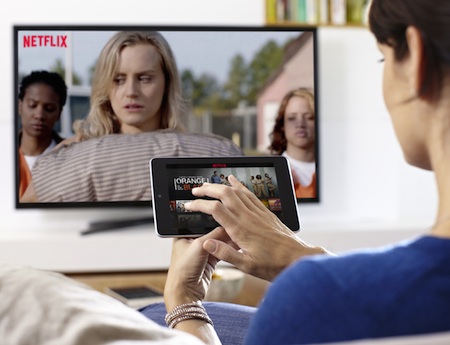Streaming Helps Cut 3Q Live TV Viewing

The decline in traditional TV viewing is accelerating as more viewers use streaming services, time shifting and digital devices to watch video, Nielsen says.
Nielsen has renamed its quarterly Cross Platform Report as a Total Audience Report, designed to capture changing viewer behavior.
In the third quarter, live TV consumption dropped to four hours and 32 minutes per day from four hours and 44 minutes a year ago, the report said, and watching time shifted rose to 30 minutes per day from 28 minutes.
At the same time, time spent using a smart phone jumped to one hour and 33 minutes from one hour and 10 minutes and the amount of time spent on a computer using the Internet rose to 1 hour and six minutes from one hour.
The increased accessibility of content on digital devices is giving consumers more choices, and the result is increased use at a time when traditional TV ratings are showing marked declines. That might be especially true in the third quarter, when summer programming including reruns drives viewers to experiment.
Subscription video on demand, now in 40% of homes, is up 19%. (Nielsen says the effect of putting current shows on streaming services like Netflix is a mixed bag. In some cases the ability to catch up on previous seasons boosts ratings. But in other cases, traditional ad supported viewing has gone down.)
Tablets are in 47% of homes and usage is up 59%. Smart TVs are in 13% of homes and usage is up 78%.
Broadcasting & Cable Newsletter
The smarter way to stay on top of broadcasting and cable industry. Sign up below
The number of homes with broadband but no multi-channel pay-TV service has increased to 2.8 million from 1.1 million last October, when those homes began to be included in the Nielsen sample.
As the leader in producing viewership data Nielsen has been challenged by the changes in technology and criticized by clients. Collecting data has become more difficult as illustrated by a glitch Nielsen and its clients discovered in October that led to the ratings being recalculated for the first weeks of the Fall season.
Viewership of Netflix is growing, but Netflix and other streamers make gathering audience information about their programs difficult. And Nielsen also faces a growing rival in the measurement business in Rentrak, now partly owned by advertising powerhouse WPP.
“While we are not seeing a departure from media content consumption, we do see a shift in consumer behavior and today we see a resounding growth in consumption on digital platforms,” Dounia Turrill, senior VP, insights, at Nielsen, said in the report. “The growing penetration of new devices and the popularity of subscription-based streaming services, time shifting and over-the-top viewing—as well as cord-cutting and cord shaving—are fundamentally changing the TV industry.”
Turrill said that the industry is at a crossroads and that Nielsen’s goal is to create a total measurement of all content and all ads “regardless of how they are accessed and the ad model that they’re supporting.”
The growth of video consumption is spreading among age groups, with older viewers starting to exhibit behaviors first associated with younger consumers. With people 55 years of age and older, digital video is up 55%, while TV screen time is unchanged. For people 25 to 54, time spent with digital video is up 62%, with TV viewing down 2%. And among people 18 to 49, digital video time is up 53%, while TV time is down 3%.
Nielsen notes that the heaviest users of streaming services are also the heaviest TV viewers.
And while viewers have more choices than ever, they’re watching fewer TV channels. The average number of channels viewed was 21 in the third quarter, down from 21.7 a year ago.
Jon has been business editor of Broadcasting+Cable since 2010. He focuses on revenue-generating activities, including advertising and distribution, as well as executive intrigue and merger and acquisition activity. Just about any story is fair game, if a dollar sign can make its way into the article. Before B+C, Jon covered the industry for TVWeek, Cable World, Electronic Media, Advertising Age and The New York Post. A native New Yorker, Jon is hiding in plain sight in the suburbs of Chicago.

